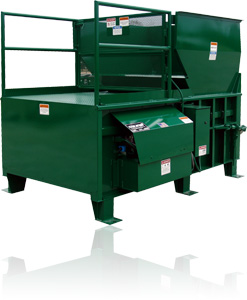Exploring the Crucial Role of Waste Devices in Modern Recycling Processes and Sustainable Garbage Disposal Practices
The critical role of waste equipment in modern-day reusing procedures emphasizes its significance in attaining lasting waste disposal practices. As the demand for more sustainable remedies grows, it is important to analyze exactly how these technologies adapt to advancing challenges within waste administration - baler rental.
Value of Waste Tools
Why is waste tools crucial in the recycling procedure? By facilitating the separation of products, waste equipment decreases contamination, which is critical in ensuring high-grade recyclables that can be reintroduced into manufacturing cycles.
Furthermore, waste equipment enhances operational efficiency and safety within recycling facilities. Advanced machinery, such as shredders and balers, enables for the rapid processing of large quantities of waste, reducing labor costs and handling time. Furthermore, making use of specialized devices reduces the threat of injury among employees by automating hazardous tasks.
Moreover, the ecological impact of recycling is amplified by efficient waste tools. By maximizing the recycling procedure, centers can substantially minimize the quantity of waste sent out to garbage dumps, consequently adding to sustainability initiatives. In final thought, waste tools is not simply a secondary part of reusing; it is a fundamental facet that drives effectiveness, safety and security, and environmental stewardship in contemporary waste monitoring practices.
Types of Waste Equipment
The effectiveness of recycling operations is closely connected to the details kinds of waste devices made use of in the procedure. baler rental. Various groups of equipment are integral to the collection, sorting, handling, and transportation of recyclable materials
To start with, collection devices, such as waste collection vehicles and bins, is essential for gathering recyclables from different sources, including property, commercial, and industrial locations. When gathered, sorting devices, consisting of conveyor belts, shredders, and magnetic separators, plays a crucial role in identifying various material types, making sure that contaminants are eliminated before handling.
Processing equipment, such as balers and compactors, additionally prepares products for reusing by compressing and packaging them right into convenient sizes. This not just enhances area yet likewise boosts transport performance. In addition, specialized machinery like granulators and extruders is utilized for transforming materials into reusable types, specifically in plastic recycling.

Function in Recycling Procedures
In reusing procedures, the role of waste equipment is pivotal in ensuring performance and efficiency at every phase. This equipment includes a series of equipment made to deal with, procedure, and type products that are to be recycled. The first stage entails collection and transportation, where compactors and balers play a vital duty in optimizing the quantity of materials for transportation, thus minimizing functional prices.
When at the reusing facility, shredders and crushers enter into play, breaking down products into workable dimensions ideal for more handling. These makers add to boosting the area of recyclables, assisting in much more reliable material healing. Sorting systems, equipped with innovative technologies such as conveyor belts and optical sensing units, guarantee that materials are properly divided by type, therefore optimizing the quality of the recycled final product.
Additionally, customized devices for processing certain products-- such as glass, plastics, and steels-- ensures that each kind is taken care of in the most efficient manner. Generally, the combination of innovative waste tools into the reusing procedure not only improves operations however likewise considerably adds to the total recovery prices of beneficial materials, underscoring its crucial role in modern recycling efforts.
Effect On Lasting Practices
With the efficient procedure of waste devices, reusing procedures significantly enhance sustainable methods throughout numerous sectors. By enhancing sorting and processing functions, progressed waste tools minimizes contamination in recyclable products, thereby enhancing the quality of recycled output.

Additionally, the combination of clever innovations in waste administration systems allows for real-time data tracking and evaluation, resulting in more educated decision-making and operational performances. As industries increasingly focus on sustainability, the role of waste tools comes to be critical fit methods that straighten with ecological stewardship and regulatory conformity. Inevitably, the synergy between waste devices and reusing procedures plays a crucial role in advancing more comprehensive sustainability objectives across areas and sectors alike.
Future Fads in Waste Monitoring
Arising fads in waste management are positioned to reshape the landscape of recycling and resource healing substantially. Smart waste bins equipped with sensing units can keep an eye on waste levels in real-time, optimizing collection paths and minimizing functional prices.
In addition, the circular economy model is getting grip, promoting the idea of reusing materials as opposed to dealing with them. This pattern encourages organizations to make products with end-of-life considerations in mind, driving the requirement for ingenious waste administration services.
Additionally, public awareness and interaction in sustainability this hyperlink techniques are on the rise, leading to boosted engagement in reusing programs. Government plans are likewise progressing, with stricter regulations on waste disposal and rewards for lasting techniques.
As these fads merge, they produce a much more efficient, lasting waste monitoring system that not just decreases environmental impact yet additionally cultivates financial development via resource recuperation and advancement in waste devices. The future of waste monitoring looks promising, driven by modern technology and a commitment to sustainability.
Verdict
Finally, waste tools plays a pivotal role in improving the effectiveness and efficiency of contemporary reusing procedures. By lessening contamination and making best use of material healing, progressed equipment sustains lasting garbage advice disposal practices and fosters a circular economic climate. The incorporation of clever technologies better maximizes these efforts, ensuring liable ecological stewardship. As waste monitoring continues to evolve, the significance of cutting-edge waste equipment will continue to be extremely important in attaining sustainability objectives and resolving the difficulties of resource deficiency.